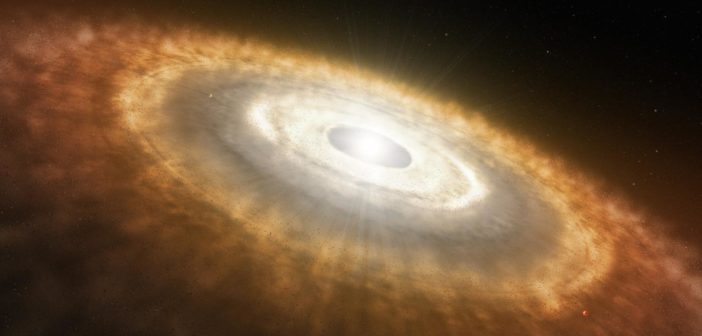Editor’s note: Astrobites is a graduate-student-run organization that digests astrophysical literature for undergraduate students. As part of the partnership between the AAS and astrobites, we repost astrobites content here at AAS Nova once a week. We hope you enjoy this post from astrobites; the original can be viewed at astrobites.org!
Title: Probing the Cold Dust Emission in the AB Aur Disk: A Dust Trap in a Decaying Vortex?
Authors: Asunción Fuente, Clément Baruteau, Roberto Neri, et al.
First Author’s Institution: Spanish National Observatory (OAN, IGN)
Status: Published in ApJL, open access
Planet formation still holds many mysteries for today’s astronomers. One of the biggest unknown is how pebbles and dust clump together to form planetesimals rather than drifting in towards the star due to its strong gravitational pull. A possible solution is dust traps — in a circumstellar disk, the inward drift of the pebbles and particles can be stopped by high pressure in the gaseous disk. A dust trap like this would be an ideal place to form planetesimals. The authors of today’s paper look at a circumstellar disks around AB Aur. They create hydrodynamical simulations of the dust and gas to see if there is a dust trap with the possible formation of small planets.
Circumstellar disks are the link between bunches of dust around a star and fully formed planetesimals. There are a few types of circumstellar disks — protoplanetary, transition, and debris. A transition disk is exactly what it sounds like — a transition from protoplanetary to debris, which means that planets would likely be forming in a transition disk. About 450 light-years away from us, AB Aur hosts an asymmetric transition disk. The unevenness of the disk could indicate a dust trap or gas vortex. At about 120 AU from the central star, the cold dust emission disk creates an asymmetric ring in the disk.
The authors use NOEMA (NOrthern Extended Millimeter Array) to observe the dust’s continuum emission at 1.12 and 2.22 mm in the AB Aur system. Their observations, shown in Figure 1, reveal that the intensity varies throughout the emission ring, and the intensity decreases at higher wavlengths. The intensity variations that the authors observed are smaller at 2.22 mm than at 1.12 mm, which is the opposite of what purely theoretical dust-trapping/gas-vortex models predict.
Figure 2: The simulations of gas created by the authors. The four images on the left show the distribution and density of gas, and the four images on the right show the continuum emission reproduced from the simulated gas distributions. [Fuente et al. 2017]
The authors’ gas and dust simulations show a dust-trapping feature in the disk at about 96 AU. The vortex would need to be decaying as the planet formed in order to fully reproduce their observations, including the intensity varations along the ring. More observations and work are needed to fully understand the disk, but so far the authors’ simulations show that planets and planetesimals are likely currently forming in a dust trap around AB Aur.
About the author, Mara Zimmerman:
Mara is working on her PhD in Astronomy at the University of Wyoming. She has done research with binary stars, including Heartbeat stars, and currently works on modeling debris disks.


1 Comment
Pingback: Making planetesimals